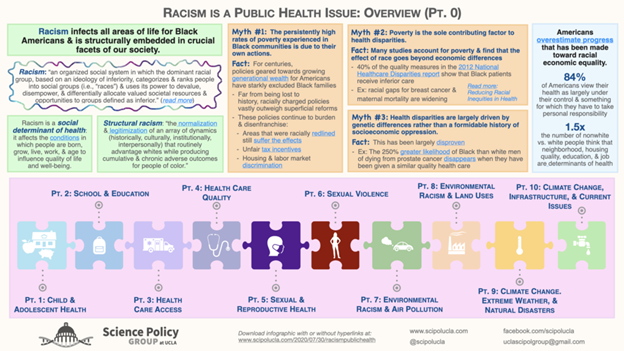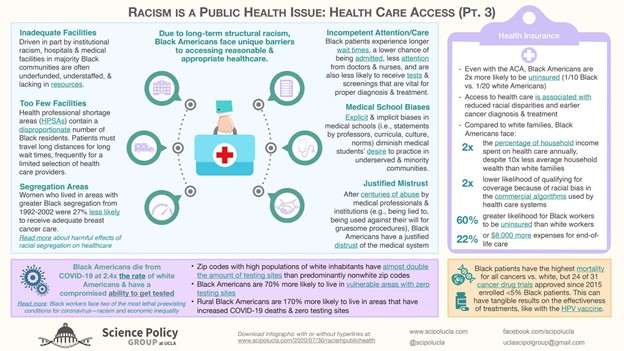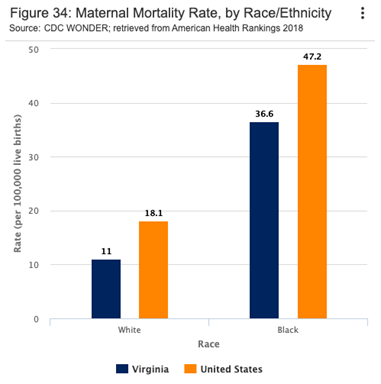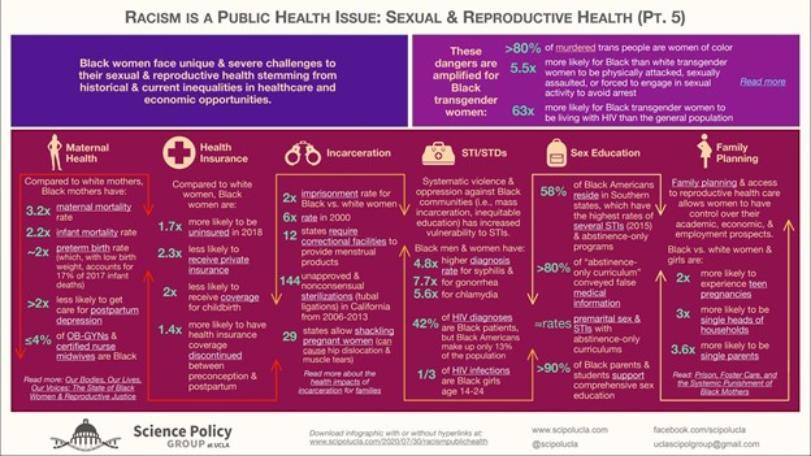Health Care Quality and Access
Structural racism in the United States negatively affects health outcomes of black people nationally and plays a unique and complex role in health care quality and access, which is closely related to the other four social determinants of health domains.1,2 As such, we will focus this module on the racial disparities evident in maternal health as a profound example for how racism directly impacts the quality and access to health care of the people in the communities that VCU Health serves.
In Virginia, black women have a 2.3-fold higher rate of pregnancy-associated mortality compared with white women, even when controlling for confounding factors such as socioeconomic or education status.3 In Richmond, infants born to black women die at a rate of 1.5 to 3 times more when compared with other races.3 On the other hand, black women report lower quality of maternal health care received. For example, VCU Health patient experience surveys show lower satisfaction in quality of care for black patients, such as communication with clinicians, understanding how to manage their health, and perceived respect from nursing staff, when compared with white patients on the maternal inpatient ward (VCU Health Department of Patient Centered Services, email communication, June 2021). This module will enlighten the reader about historical and current reasons as to why black women experience poorer quality care and worse outcomes in pregnancy as well as the main ways racism impacts the care of black patients in general.

Midwife Centering Pregnancy Reunion (photo by Lindy Rodman, VCU University Relations)
Learning Objectives:
- Describe the role of racial disparities in increasing the risk of maternal morbidity and mortality experienced by black women
- Identify major contributing factors that lead to black individuals having poorer access to and lower quality of healthcare in Virginia
- Discuss opportunities to reduce disparities in health care access and quality of black individuals in the communities served by VCU Health
NOTE: Users who are pursuing either History and Health badge, credit through the VCU Health System DEI learning requirement, or those who would like to claim continuing education credit must complete and submit the Reflection Activity at the bottom of this page. Please visit VCU Health Continuing Education for more information.
Contributing factors to unequal outcomes
We know from extensive research into the archives of the Medical College of Virginia that black people seeking medical care were often treated inhumanely compared to their white counterparts.4 Alongside policies and other structural entities, overt racism has led to worse health outcomes for black people. Interviews of community members suggest mistrust and fear of the providers at VCU Health creates hesitancy to follow through with doctor visits further perpetuating poor outcomes. Finally, implicit and explicit biases of providers lead to poorer quality of healthcare when black patients interact with the healthcare system (see: Racism is a Public Health Issue: Health Care Quality PT. 4).
Review the infographics from the Science Policy Group at UCLA



Resources
We ask that you spend the hour reading and viewing the resources above and viewing as many of the linked resources below as possible prior to completing the reflection activity. Reflections will be evaluated, and individuals may be asked to resubmit if answers are incomplete or do not meet the length requirement.
READINGS
The ‘Father of Modern Gynecology’ Performed Shocking Experiments on Enslaved Women - The History Channel
A Multifaceted Approach to Addressing Persistent and Dire Health Disparities - The National Partnership for Women and Families
A Mother's Cry: A Race to Eliminate the Influence of Racial Disparities on Maternal Morbidity and Mortality Rates Among Black Women in America
Eliminating Racial Disparities in Maternal and Infant Mortality: A Comprehensive Policy Blueprint - The Center for American Progress
Training Internal Medicine Residents To Act On Social Determinants Of Health Using Social Determinants Of Health Fast Facts
Fewer Pharmacies In Black And Hispanic/Latino Neighborhoods Compared With White Or Diverse Neighborhoods, 2007–15
BOOKS:
H. McGuire, Jr., “Medical College of Virginia Hospitals: 125 Years of Health Care 1861-1986
Rice, M. and Jones, W., Public Policy and the Black Hospital: From Slavery to Segregation to Integration, Greenwood Press, 1994,
Thomas, K., The Hill-Burton Act and civil rights: expanding hospital care for black southerners, 1939-1960, Journal of Southern History, November 1, 2006
Thick - by Tressie McMillan Cottom
VIDEOS:
- Red Table Talk (Season 4, Episode 6) - The Invisible Black Woman Epidemic (available on Facebook Watch)
- Virginia Neonatal Perinatal Collaborative Youtube channel
COMMUNITY PARTNERS:
- Urban Baby Beginnings - Project ReByrth and Perinatal Safe Spots
Reflection activity directions
Users who are pursuing VCU’s History and Health; Racial Equity badge, credit through VCU Health System DEI learning requirement or those who would like to claim continuing education credit must complete and submit the Reflection Activity. The form asks the user to submit basic biographical information (e.g., name, department) and to answer one of the following 3 prompts. Your response must be a minimum of 250 words. Reflections will be evaluated, and individuals may be asked to resubmit if answers are incomplete or do not meet the length requirement.
Identify a time in your life, be it in your practice, position, or personal life, when you may have witnessed a racial disparity in healthcare but either did not recognize or address it.
PROMPT OPTION 1: How would you have acted differently after reviewing the information presented in this module?
PROMPT OPTION 2: Considering your training and further professional development, identify systematic situations that were in place that may have prevented you from recognizing and/or addressing the problem.
PROMPT OPTION 3: Outline steps to overcome or change these structural or systemic barriers. Consider using resources provided in this module to find opportunities to work to combat these barriers in your community and/or practice.

